 The price of gold has steadily risen since the start of the COVID-19 pandemic. There are a number of reasons for this, and the most obvious is that gold is always seen as a ‘safe haven’, or a store of value. As a physical commodity, gold cannot be printed like money, and its value is largely unaffected by government interest rate decisions.
The price of gold has steadily risen since the start of the COVID-19 pandemic. There are a number of reasons for this, and the most obvious is that gold is always seen as a ‘safe haven’, or a store of value. As a physical commodity, gold cannot be printed like money, and its value is largely unaffected by government interest rate decisions.
For that reason gold has historically maintained its value over time; it serves as a form of insurance against adverse economic events, of which the global pandemic is an example.
If the above is accepted as a ‘truism’, then how does the price of gold affect consumer demand for gold jewellery?
It’s an good question and one that is not easily answered on a global scale, largely because of differing ‘relationships’ some cultures have with gold. Think India!
However, given the world has just experienced a significant global catastrophe, and the gold price increased during the time, it does allow us to analyse and compare what has happened over the past two years.
While the pandemic significantly impacted many industries and international markets throughout 2020, gold was largely unaffected; in January it was priced at around $US1,550 per ounce, a price at which it rarely fell below. By December 2020 it had increased to more than $US1,800 per ounce.
Plunge in sales
On the international front, data from the World Gold Council (WGC) indicates that jewellery sales plunged: “Jewellery demand in 2020 dropped to its lowest annual level on record, decimated by the combination of the global pandemic – with its resultant market lockdowns – and record-high gold prices at a time of economic slowdown.”
The January 2021 report explains that “total annual jewellery demand dropped to 1,411.6t, the lowest in our annual data series and 34 per cent lower year-on-year. The two largest markets, India and China, were the two major contributors to the annual decline.” (See Chart A)
Understandably, the WGC collates historical annual data back to 1995. The report goes on to explain that “although jewellery demand showed continued signs of quarterly recovery from the lows reached in Q2 when market lockdowns were at their peak, it remained very weak in Q4.”
However, the news was not all bad because the WGC predicted that “while jewellery demand volumes were likely to remain relatively subdued as COVID-19 continues to impede the normal functioning of many markets across the globe, mass vaccination program and signs of improving economic indicators imply that we expect to see continued, if tentative, improvement in the sector in 2021.”
And so it was that by July this year the WGC was reporting that “jewellery demand (390.7t) continued to rebound from 2020’s COVID-hit weakness, although remained well below typical pre-pandemic levels, partly due to weaker Indian demand growth and only a few months later its October report declared that “Jewellery continued to draw strength from the ongoing global economic recovery: Q3 demand rebounded 33% year-on-year to 443t.”
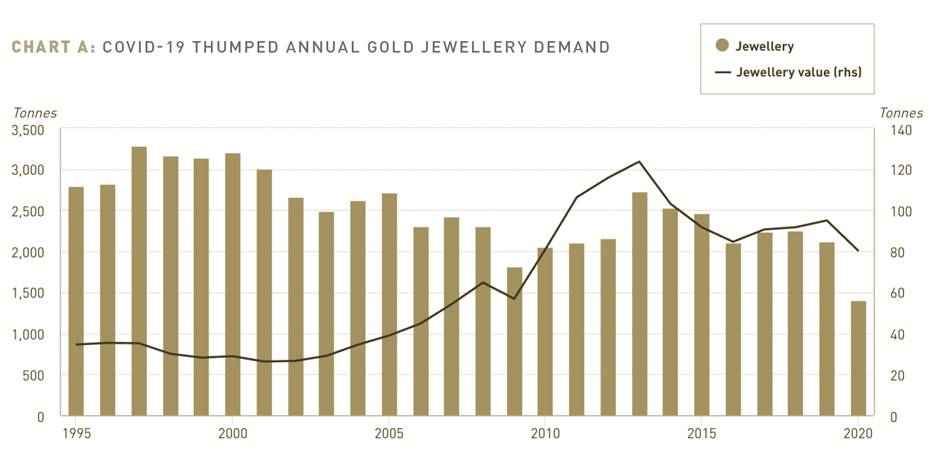 |
Sources: ICE Benchmark Administration, Metals Focus, Refinitiv GFMS, World Gold Council;
Note: Data as of 31 December 2020. Jewellery value is calculated by multiplying the tonnagefigure and the annual average LBMA Gold Price PM in US dollars |
Macro versus micro
This data is at a macro level and does not necessarily relate to the ‘at the coalface’ experience of jewellery retailers worldwide. In other words, what might be happening in one country/market may not be replicated in other markets. Local factors impact consumer buying and trends.
Mike Dyer, sales manager at Retail Edge, a specialist management consultancy firm in the retail jewellery market, details a different side or outcome from that of the WGC data.
He believes “there are several factors that influence the retail selling price of gold, the best way to measure the comparative movement would be the number of items sold, and to analyse this with just gold jewellery.
“Units sold figures for full calendar year 2019 compared to full calendar year 2020 shows just a 6.3 per cent increase in units sold. Markups [retailer margin] achieved are almost the same which points to an increase in consumer demand rather than a resistance to price.”
Of course, one explanation could be that consumers who were still buying gold jewellery during the global pandemic - and during a period of a high gold price - could have been choosing lower ‘quality’ and therefore, lowerpriced gold items.
However, Dyer’s data - collected from more than 400 independent Australian jewellery stores via the Retail Edge POS software - suggests that there was no shift to 9-carat designs rather than 18-carat to save money: “There is no evidence in the items sold information [by Retail Edge clients] that points to a drop in 18-carat unit sales and an increase in the 9-carat unit sales.” (See Charts B, C and D below)
The three-year data from January 2019 to October 2021 shows gold jewellery sales peaked in December 2020, just as Australian cities were re-opening after long lockdowns. It indicates that 13,300 gold jewellery units were sold nationally in that month, with Australians spending close to $4.5 million on gold jewellery in December 2020, which was the highest across the entire period.
The second-highest month of the same period was December 2019 – 11,485 pieces sold, with $3.1 million spent on gold jewellery.
Interestingly, November, May and April 2020 resulted in large gold jewellery sales; 4,914, 4,521 and 4,262 units sold respectively. It should be noted that many Australian capital cities were in lockdown during these months and, despite this, Australian consumers continued to purchase gold jewellery.
Further, the highest performing months in 2020 outrank their respective (pre-pandemic) months in 2019 - despite the gold pricing rising across 2020.
During this timeframe, the gold price peaked in August 2020 at more than $US2,000 per ounce and yet Australian gold jewellery sales across the Retail Edge client stores remained high in the same period; with 3,643 gold jewellery units sold in August 2020, beating August 2019’s 3,246.
2019 - 2021 GOLD JEWELLERY SALESTRENDS THROUGH DATAThe charts below compare the sales of gold jewellery for the past three years - 2019, 2020 and 2021 (October).
The data is a representative sample of more than 400 independent Australian jewellery stores collected via
Retail Edge POS software during a time where the price of gold has steadily increased. |
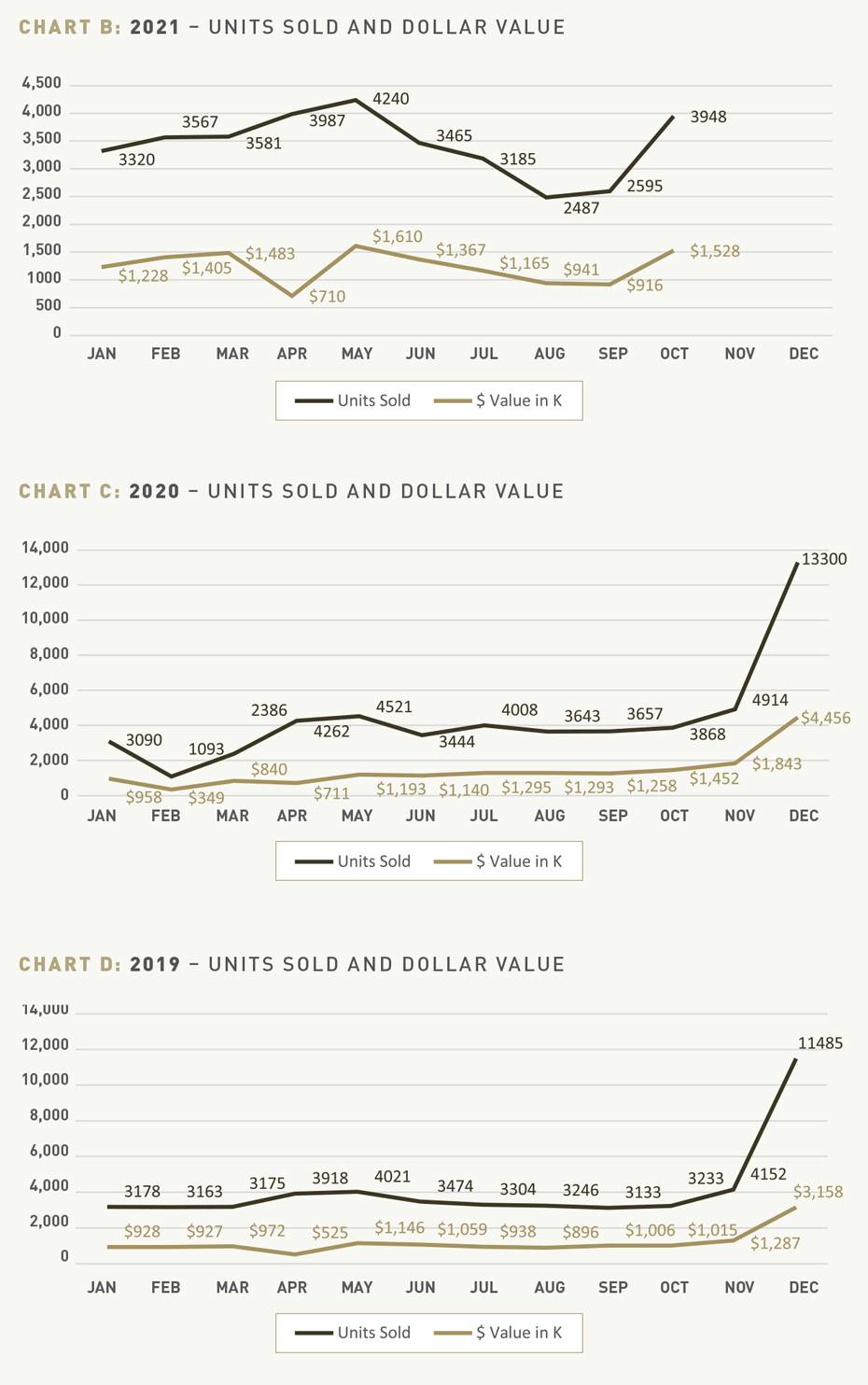
|
Turning the table
Jeffrey Christian, partner CPM Group, a New York based commodities research and consulting firm has another slant on the topic: “Yes, it is correct that overall higher gold prices lead to less gold being used in jewellery. Similarly lower prices will lead to more jewellery demand. It is not just high prices but also volatile prices that reduce gold use in jewellery”.
He explains that the decline in demand occurs at two levels, “Jewellers reduce their per unit gold content in their jewellery to keep the jewellery ‘affordable’ and within ‘price points’ that are attractive to consumers. Consumers react to higher gold prices partly because there is some increase in the jewellery prices and partly because of the perception that higher gold prices ‘no doubt’ are increasing jewellery prices.”
Christian’s experience in the industry is long, and in fact in an open letter to mining company executives dated January 2001, he indicated that gold jewellery production has little or no effect on the price of gold: “Over the past few months CPM Group has been asked by executives at several gold mining companies that are clients of ours about the price implications of rising jewellery and/or investment demand for gold. Gold prices never will rise significantly due to growth in jewellery demand,” he wrote 20 years ago.
In 2000, and when the gold price were at a low of $US271 per ounce, the head of a bullion trading company commissioned an advertising agency to create a ‘pitch’ to the gold mining industry for a consumer advertising and marketing campaign to promote gold jewellery, in a similar way that De Beers once ran generic campaigns promoting diamond jewellery to consumers.
Following lengthy research, Christian advised the gold miners: “As it has been explained to us by several gold producers, the gold mining industry is being asked to spend large amounts of scarce financial resources to promote gold use in jewellery. The marketing people behind this promotional effort are said to have been producers that only by stimulating gold jewellery demand can producers ever hope to see gold prices rise.
“While it is a noble and worthy effort for producers to promote gold jewellery, mining industry executives must understand that it is impossible to drive gold prices significantly higher on a sustained basis with jewellery demand.”
It should be remembered that his comments are coming from the ‘other side of the fence’. That is, how gold jewellery production affects the price of gold bullion rather than how the price of gold bullion affects the pricing of gold jewellery manufacture, which then affects jewellery retailers, especially small independent stores.
Christian told Jeweller: There are four broad issues that affect the volume of gold used in jewellery design and manufacture, as well as consumer demand for gold jewellery:
• Gold and jewellery prices
• Income levels, disposable income, senses of economic well-being
• Fashion trends
• Advertising
“In the end the mining companies rejected the proposed consumer advertising program.”
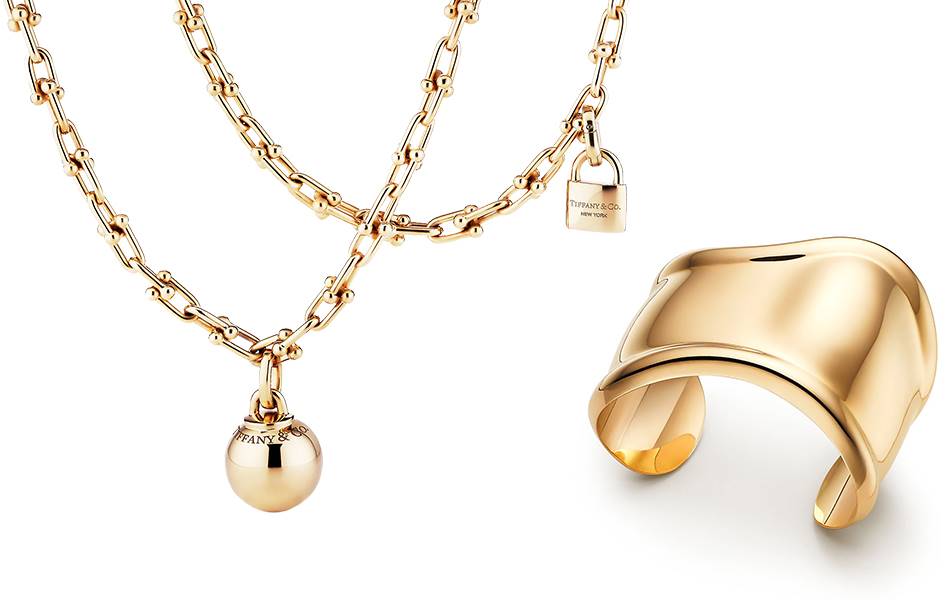
|
| Above: Tiffany & Co |
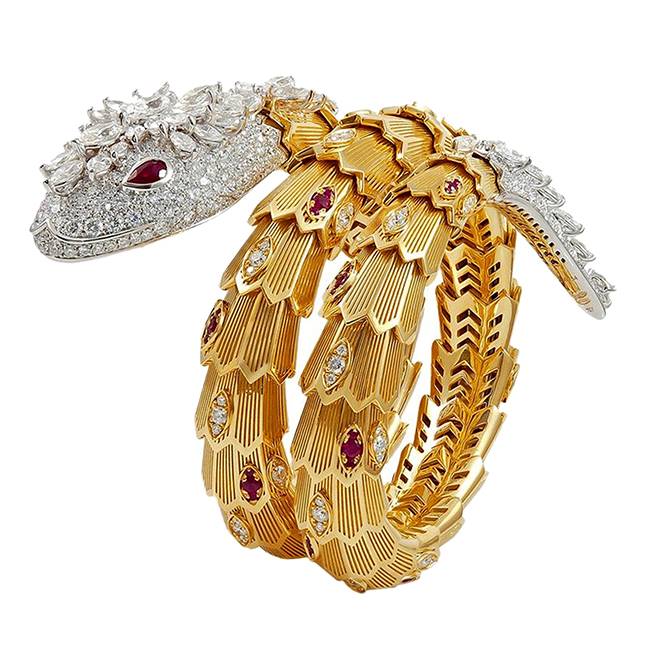 | 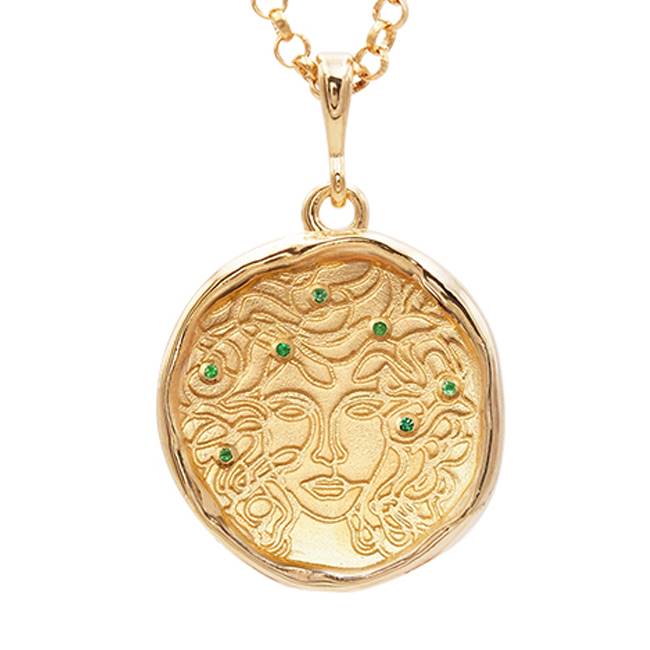 | 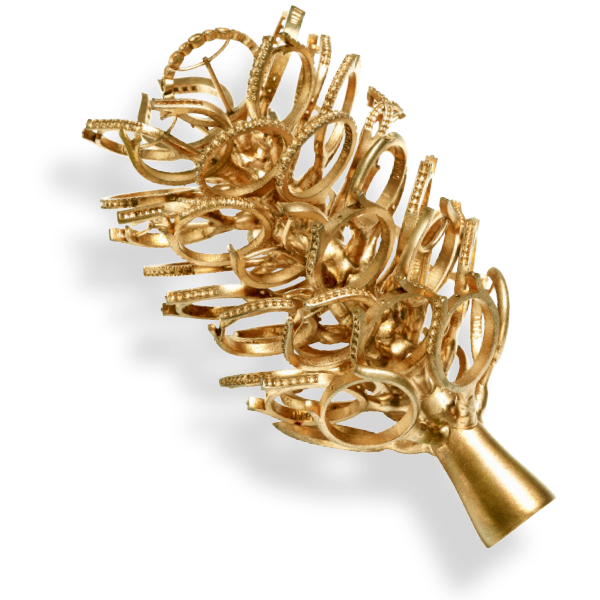 |
Above: Bulgari | Above: Common Era | Above: Palloys |
Think globally act locally
One of the important lessons from the pandemic is the fragility of globalisation; supply chains and channels fell apart. Suddenly buying local became not only paramount but also the only option.
James Bishop, operations manager Morris and Watson, one of Australia’s largest chain jewellery manufacturers and refiners, says, “The pandemic has impacted a number of industries over the last two years so it is difficult to narrow down a particular trend specific to the jewellery industry. While the price per gram for gold has increased this has not had a negative impact on sales.
“Jewellers appear to be very busy despite the interruptions due to the pandemic, this is possibly a result of national and international travel restrictions ensuring people spend their money locally.” He believes that COVID-19 has focused many retail businesses on local supply.
“More jewellers and retailers of all sizes are also looking to purchase from local suppliers due to national and international supply chain disruptions and a customer base that is becoming more socially and environmentally focused,” Bishop says.
Jacinta Collins, general manager Golden Mile Jewellery Manufacturers, says that “definitely, when the price of gold jumps up, traditionally it always meant that retailers held off on re-ordering stock, in the hope that the price would drop down again.
"When the gold price didn’t drop down but instead continued to climb further, we found that retailers realised that they better hurry up and re-order.” “If retailers left it too late, then they’d find that they weren’t able to replenish their stock to the same level as the amount they want to spend now, and it would get them a reduced amount of stock to what they had previously.”
However, according to Collins, things have changed over the past few years: “We have seen much less of that [retailers not re-ordering], and we are noticing customers replenishing their stock more regularly with automated orders that keep their stock levels constantly topped up without needing to invest in a big lump sum.”
Chris Botha, operations manager Palloys, says that sales of gold jewellery has remained “roughly the same, however, a notable change is a reduction in the purity of gold. Higher gold prices will often see people opt for 9-carat and 14-carat jewellery over 18-carat.
“It’s not a lockstep correlation, but you’ll often see jewellery sales increase in the 9-carat range rather than 18-carat as the price of fine gold increases.”
Interestingly, Botha points to another side effect. There can also be an increase in demand for platinum as a result of gold volatility: “We have noticed in the past that as the gold prices have increased, platinum sales have nearly tripled, as customers looks for less expensive alternatives.”
Arthur Papagrigoriou, director of Melbourne-based Athan Wholesalers, specialising in 9- and 18-carat pendant chains and imported Italian chains, is another who says that the gold price affects sales.
“We found a correlation in the increase in the gold price and reduced gold jewellery sales during the first sudden price rises in 2006, gold increased and sales decreased, however, in recent times it [sales] seems to be more steady. And there was definitely a shift from 18-carat to 9-carat as the gold price increased as many find the price of 18-carat out of reach,” Papagrigoriou explained.
Bishop says that Morris and Watson’s experience has been different. “While there are always priceconscious shoppers who lean towards 9-carat gold, 18-carat gold will always remain a popular option with many jewellers and their customers.”
Collins echoes Bishop’s view. “Something I have noticed is that when gold prices rise, the consumers are more interested in buying large 18-carat pieces, and we quote a lot more of these when the gold price rises. However, most consumers realise that it is much more expensive than they expected and generally end up buying 9-carat as it is the more affordable option,” she says.
Industry stalwart, Ted Pevy, director Jewellery Centre, established in 1977, is well placed to look at long-term trends.
“We are seeing a move to women wearing fewer pieces, but better pieces and gold fits into that description as well. Where they had lots of little chains, now it’s one bigger, better chain. As far as the gold price is concerned, it actually increases the desirability of gold jewellery.”
Pevy also says that while 9-carat gold pieces are the more popular item, “18-carat gold jewellery sales certainly have increased and our experience is we are selling more 18-carat than we have for quite a long time.”
Bishop adds that there has been “a renewed interest in 14-carat gold in the last couple of years, offering a third option for people conscious of both metal value and price. This can be helpful for anyone that is unable to decide between 9-carat and 18-carat gold.”
What can we make of all of this? Well, one thing is clear, there is no definitive answer as to if, and how, the price of gold affects sales of gold jewellery, other than to say a trend in one market may not be relevant to other markets. There is no simple answer in a topsy-turvy world; and in a world that has seen many ups and downs in the past two years, it would be a bold person to claim they have the answers.
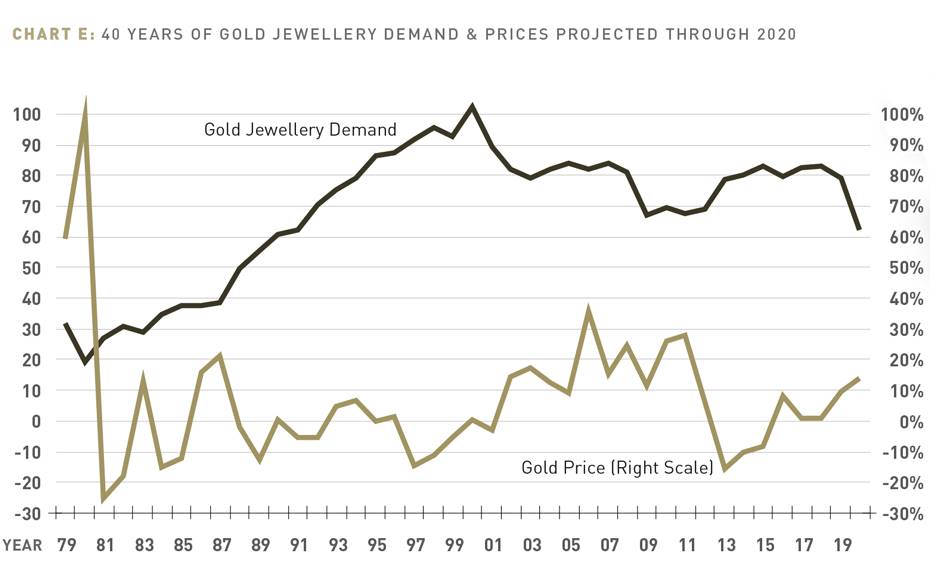 |
Source: CPM Gold Yearbook 2021 |

HISTORICAL PERSPECTIVE
Colin Pocklington, managing director Nationwide Jewellers, Australia and New Zealand's largest jewellery industry buying group offers an historical insight.
The change in the price of gold over the past 40 years has had a major influence on sales of gold jewellery, as would be expected. When I worked at Hooker Retail (Prouds, Edments and Diamond Traders) during the 1970s and early 1980s, the gold price was quite steady, and a lot cheaper than today. Therefore, sales of gold jewellery were not impacted to any great degree by gold price volatility However, the floating of the Australian dollar in 1983 added an additional volatility factor – currency changes. Once gold jewellery prices started to escalate – as a result of the combination of higher gold prices and a drop in the AUD/USD rate – sales of gold jewellery were heavily impacted. Consumers would ask for an 18-carat gold chain, but when they realised the cost, would buy 9-carat instead. Additionally, as prices continued to increase from 2005, consumers would often switch from gold to silver. Back in the 1970s and 1980s gold jewellery sales were about 15-20 per cent of sales for an ‘average’ jewellery store, with silver jewellery only 5 percent. For most of the past 20 years, these figures have been reversed, with silver jewellery outselling gold jewellery. Several years ago, there was a resurgence in sales of gold jewellery – our theory is that many consumers have only known gold jewellery to be at current price levels, and have not experienced significant increases since 2000. The most surprising change in gold jewellery sales occurred in 2020/21 with sales of non-stone-set gold jewellery increasing by about 100 per cent from September 2020 when compared to 2019 sales. While jewellery sales overall benefitted from the post lockdown sales surge, sales of gold and diamond jewellery were particularly strong, and I think there are two reasons for this: 1. Consumers who would normally earmark money for overseas/expensive holidays spent on valuable items of jewellery 2. Some consumers purchased gold jewellery on the basis that it doubles as a commodity / safe haven for their money. |
read emag